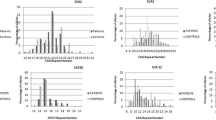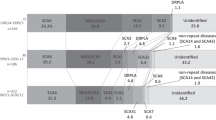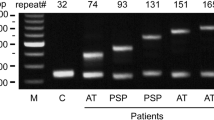Abstract.
Spinocerebellar ataxia type 17 (SCA17) is a dominant progressive neurodegenerative disorder, caused by a triplet repeat expansion within the TATA-binding protein. As well as ataxia and dementia, Parkinsonism and dystonia are common in SCA17. In some pedigrees focal dystonia in the absence of ataxia has been described as a main clinical feature. To evaluate the relevance of SCA17 mutations for primary dystonia, we examined the TBP repeat expansion in a series of 288 patients with different subtypes of primary torsion dystonia. We did not find any repeat sizes in the pathogenic range. We conclude that the SCA17 repeat expansion is not a common cause of familial and sporadic dystonia.
Similar content being viewed by others
References
Fahn S, Eldridge R (1976) Definition of dystonia and classification of the dystonic states. Adv Neurol 14:1–5
Fletcher NA, Stell R, Harding AE, Marsden CD (1988) Degenerative cerebellar ataxia and focal dystonia. Mov Disord 3:336–342
Grundmann K, Laubis-Herrmann U, Bauer I, Dressler D, Vollmer-Haase J, Bauer P, Stuhrmann M, Schulte T, Schols L, Topka H, Riess O (2003) Frequency and phenotypic variability of the GAG deletion of the DYT1 gene in an unselected group of patients with dystonia. Arch Neurol 60:1266–1270
Grundmann K, Laubis-Herrmann U, Dressler D, Vollmer-Haase J, Bauer P, Stuhrmann M, Schulte T, Schöls L, Topka H, Riess O (2003) Lack of Mutations in the Epsilon-Sarcoglycan Gene in Patients with Different Subtypes of Dystonias. Mov Disord 2004, DOI 10.002/mds.20128 published online 24.05.2004
Hernandez D, Hanson M, Singleton A, Gwinn H, Freeman J, Ravina B, Doheny D, Gallardo M, Weiser R, Hardy J, Singleton A (2003) Mutation at the SCA17 locus is not a common cause of parkinsonism. Parkinsonism Relat Disord 9:317–320
Kabakci K, Hedrich K, Leung JC, Mitterer M, Vieregge P, Lencer R, Hagenah J, Garrels J, Witt K, Klostermann F, Svetel M, Friedman J, Kostic V, Bressman SB, Breakefield XO, Ozelius LJ, Pramstaller PP, Klein C (2004) Mutations in DYT1: extension of the phenotypic and mutational spectrum. Neurology 62:395–400
Koide R, Kobayashi S, Shimohata T, Ikeuchi T, Maruyama M, Saito M, Yamada M, Takahashi H, Tsuji S (1999) A neurological disease caused by an expanded CAG trinucleotide repeat in the TATA-binding protein gene: a new polyglutamine disease? Hum Mol Genet 8:2047–2053
Kuoppamaki M, Giunti P, Quinn N, Wood NW, Bhatia KP (2003) Slowly progressive cerebellar ataxia and cervical dystonia: clinical presentation of a new form of spinocerebellar ataxia? Mov Disord 18:200–206
Lees A (1990) Dystonia and cerebellar ataxia. Mov Disord 5:178
Nakamura K, Jeong SY, Uchihara T, Anno M, Nagashima K, Nagashima T, Ikeda S, Tsuji S, Kanazawa I (2001) SCA17, a novel autosomal dominant cerebellar ataxia caused by an expanded polyglutamine in TATA-binding protein. Hum Mol Genet 10:1441–1448
Reid SJ, Rees MI, van Roon M, Jones AL, MacDonald ME, Sutherland G, During MJ, Faull RL, Owen MJ, Dragunow M, Snell RG (2003) Molecular investigation of TBP allele length: a SCA17 cellular model and population study. Neurobiol Dis 13:37–45
Rolfs A, Koeppen AH, Bauer I, Bauer P, Buhlmann S, Topka H, Schols L, Riess O (2003) Clinical features and neuropathology of autosomal dominant spinocerebellar ataxia (SCA17). Ann Neurol 54:367–375
Schols L, Peters S, Szymanski S, Kruger R, Lange S, Hardt C, Riess O, Przuntek H (2000) Extrapyramidal motor signs in degenerative ataxias. Arch Neurol 57:1495–1500
Stevanin G, Fujigasaki H, Lebre AS, Camuzat A, Jeannequin C, Dode C, Takahashi J, San C, Bellance R, Brice A, Durr A (2003) Huntington’s disease-like phenotype due to trinucleotide repeat expansions in the TBP and JPH3 genes. Brain 126:1599–1603
Zuhlke C, Hellenbroich Y, Dalski A, Kononowa N, Hagenah J, Vieregge P, Riess O, Klein C, Schwinger E (2001) Different types of repeat expansion in the TATA-binding protein gene are associated with a new form of inherited ataxia. Eur J Hum Genet 9:160–164
Author information
Authors and Affiliations
Corresponding author
Rights and permissions
About this article
Cite this article
Grundmann, K., Laubis-Herrmann, U., Dressler, D. et al. Mutation at the SCA17 locus is not a common cause of primary dystonia. J Neurol 251, 1232–1234 (2004). https://doi.org/10.1007/s00415-004-0520-2
Received:
Revised:
Accepted:
Issue Date:
DOI: https://doi.org/10.1007/s00415-004-0520-2




